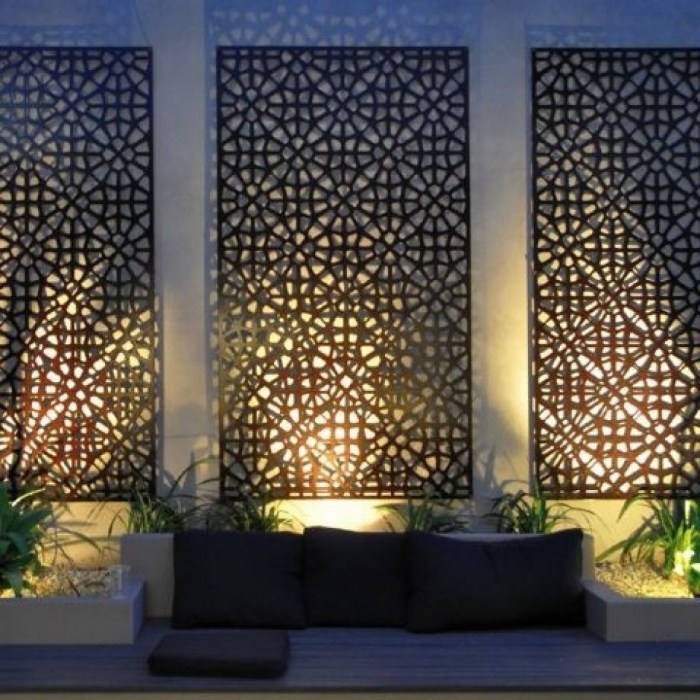Decorative screens offer a versatile and stylish way to transform any interior. From classic wooden panels to modern metal designs, these functional art pieces redefine space, offering privacy, enhancing acoustics, and adding a unique aesthetic flair. This comprehensive guide explores the diverse world of decorative screens, delving into their various types, uses, design styles, maintenance, and DIY possibilities, empowering you to make informed choices for your home or business.
We’ll journey through the rich history and cultural influences shaping screen design, examining the manufacturing processes behind these captivating pieces and highlighting emerging trends that are redefining interior design. Discover how decorative screens can seamlessly blend function and beauty, creating captivating focal points and transforming ordinary spaces into extraordinary havens.
Uses of Decorative Screens

Decorative screens offer a multifaceted approach to interior design, transcending mere aesthetics to provide practical functionality and enhance the overall ambiance of a space. Their versatility allows for creative solutions in various settings, from dividing large rooms to enhancing privacy and improving acoustics. This section explores the diverse applications of decorative screens in interior design.
Beyond their aesthetic appeal, decorative screens serve crucial functional roles within interior spaces. Their primary function often involves spatial division, creating distinct zones within an open-plan layout. This is particularly useful in studios or apartments where defining separate areas for living, sleeping, or working is essential. Furthermore, screens provide a degree of privacy, subtly shielding one area from another without completely blocking light or airflow.
This is especially valuable in shared spaces or where a sense of seclusion is desired. Finally, strategically placed screens can significantly impact a room’s acoustics, absorbing sound and reducing unwanted noise levels.
Room Division with Decorative Screens
Decorative screens are highly effective tools for dividing larger spaces into more intimate zones. Their portability allows for flexible configurations, easily adaptable to changing needs. For instance, a tall, intricately carved screen can separate a living area from a dining space, creating a sense of distinct yet interconnected areas. A shorter, lighter screen might be used to define a reading nook within a larger bedroom.
The visual impact of the screen itself adds to the overall design aesthetic, unlike traditional walls which can feel more imposing.
Privacy Enhancement Using Decorative Screens
Screens offer a sophisticated alternative to solid walls for creating privacy. In bedrooms, a screen placed strategically can partially conceal the sleeping area from the rest of the room, providing a sense of seclusion without complete isolation. Similarly, in shared living spaces, a screen can create a visual buffer between different activity zones, allowing for a greater degree of personal space.
The level of privacy offered is adjustable depending on the screen’s height, material, and density. For example, a screen made of woven fabric allows for diffused light to pass through, while a more solid screen offers greater visual privacy.
Decorative Screens as Acoustic Dampeners
The material and design of a decorative screen can significantly impact its acoustic properties. Screens made of thicker materials, such as wood or fabric, absorb sound more effectively than those made of thinner materials like bamboo or metal. The surface texture also plays a role; screens with intricate carvings or patterns tend to absorb sound more effectively than those with smooth surfaces.
Strategically placing a screen in a noisy area, such as near a window or a television, can help reduce reverberation and create a quieter, more comfortable environment. For example, a large, upholstered screen placed behind a sofa can significantly dampen sound in a living room, creating a more intimate atmosphere.
Room Layout Examples
The following examples illustrate the diverse applications of decorative screens in various room layouts.
Open-Plan Living Area with Screen Divider
This layout features an open-plan living area divided by a tall, ornate wooden screen. The screen separates the living area from the dining area, creating distinct zones while maintaining a visual connection. The screen’s intricate carvings add a touch of elegance, and its dark wood finish complements the overall color scheme. The lighting is designed to highlight the screen’s details, making it a focal point of the room.
Soft furnishings, such as rugs and cushions, are used to further define the spaces created by the screen.
Bedroom with Screen-Defined Reading Nook
In this layout, a shorter, fabric-covered screen is used to define a cozy reading nook within a larger bedroom. The screen’s light, airy fabric allows natural light to filter through while still providing a sense of privacy. A comfortable armchair, a small side table, and a floor lamp create a welcoming and intimate space. The screen’s neutral color complements the bedroom’s overall palette, ensuring it doesn’t overwhelm the space.
The soft fabric of the screen also contributes to the room’s overall sense of calm and relaxation.
Studio Apartment with Screen-Created Sleeping Area
This layout showcases a studio apartment where a free-standing screen is used to separate the sleeping area from the living area. The screen is made of a combination of wood and fabric panels, providing both visual privacy and sound absorption. The wood panels add a touch of warmth, while the fabric panels soften the overall look. The screen’s design incorporates integrated shelving, adding functionality to its aesthetic role.
The use of the screen effectively creates a sense of separation and privacy within the limited space of the studio apartment.
Ultimately, decorative screens are more than just room dividers; they’re artistic expressions that enhance both the aesthetics and functionality of a space. By understanding the diverse range of materials, styles, and applications, you can confidently select the perfect screen to complement your personal style and achieve your desired ambiance. Whether you choose a ready-made screen or embark on a DIY project, the possibilities are endless, allowing you to personalize your environment and create a space that truly reflects your unique taste.